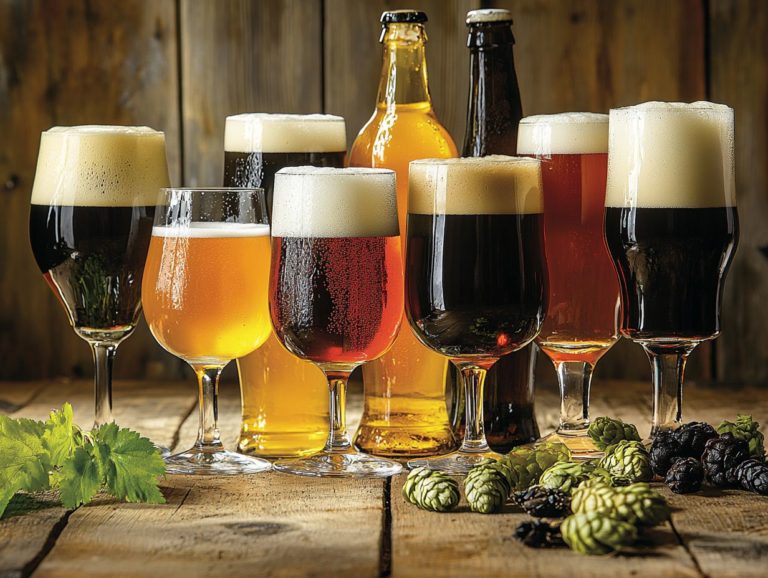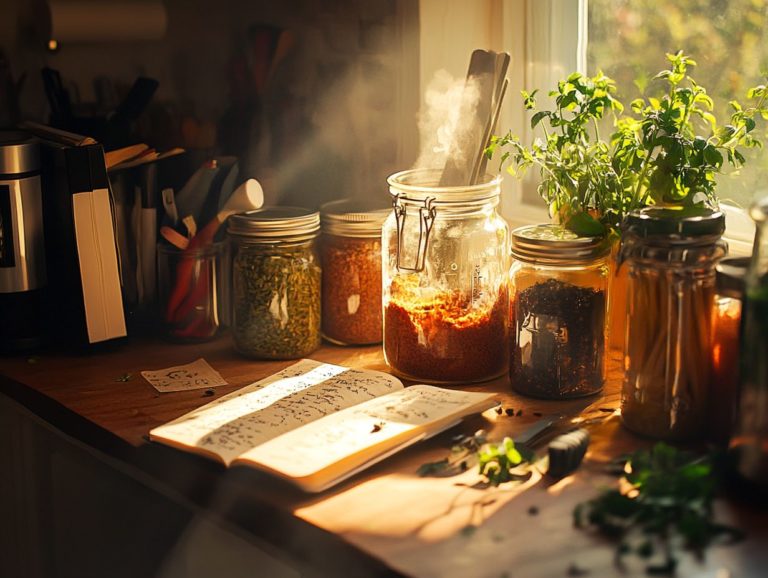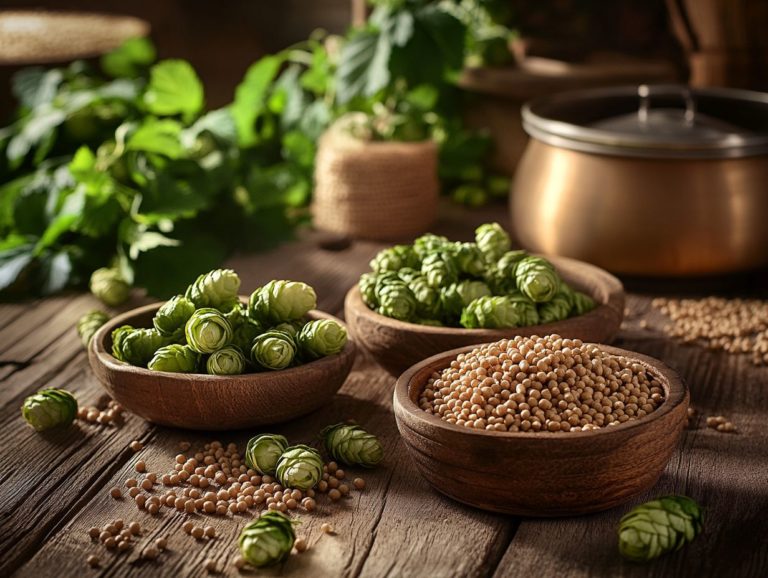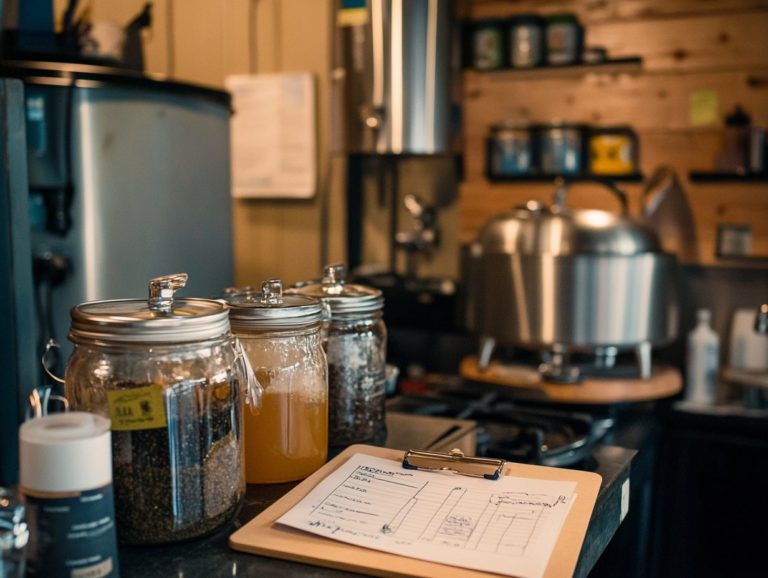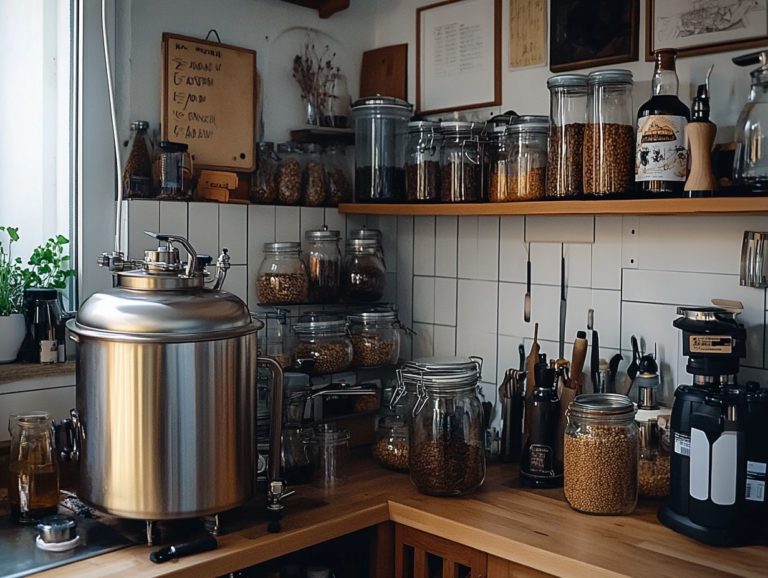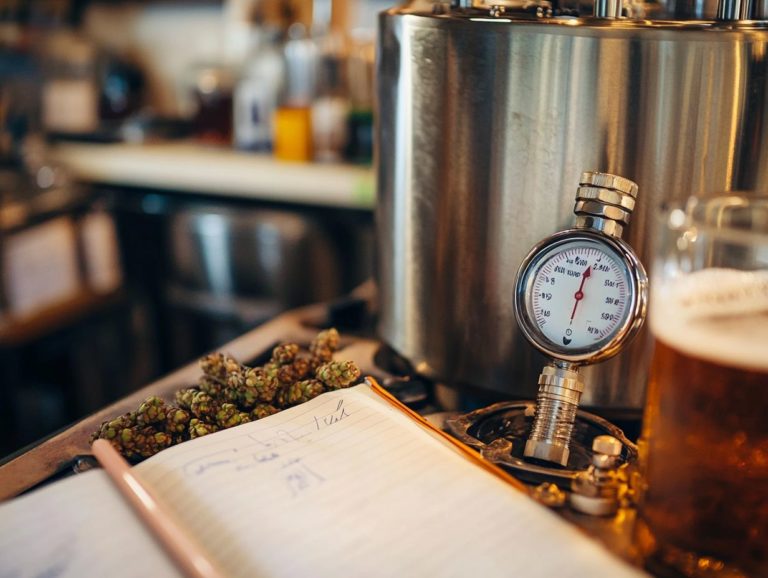How to Troubleshoot Off-Flavors in Beer
Brewing beer is a captivating blend of art and science, yet even the most experienced brewers can find themselves facing off-flavors that undermine their craft. Mastering the ability to troubleshoot these unwelcome tastes is essential for creating a home-brewed beer that’s truly satisfying and capable of impressing judges at beer competitions.
This guide will walk you through the brewing process, fermentation practices, ingredient selections, and storage techniques, equipping you to identify and resolve off-flavors with precision. You ll discover methods for detecting these flaws through visual inspection, aroma, and taste, alongside practical solutions to common brewing issues such as Diacetyl and DMS.
Armed with the right knowledge, you can elevate your brewing skills and ensure that every sip is nothing short of delightful. This knowledge will also be beneficial if you aim to participate in the Beer Judge Certification Program (BJCP).
Contents
- How to Identify Off-Flavors in Beer
- How to Fix Common Off-Flavors in Beer?
- 1. Skunky/ Lightstruck (Light Struck Flavors)
- 2. DMS (Cooked Corn/ Vegetables) (Dimethyl Sulfide Flavor)
- 3. Diacetyl (Buttery/ Butterscotch) (Diacetyl Flavor)
- 4. Acetaldehyde (Green Apple/ Cut Grass) (Acetaldehyde Flavor)
- 5. Oxidation (Stale/ Cardboard) (Oxidized Flavor)
- 6. Infection (Sour/ Vinegary) (Sour Flavor)
- 7. Metallic Flavors
- 8. Phenolic Flavors
- How to Prevent Off-Flavors in Beer?
- Common Off-Flavors in Beer
Key Takeaways:
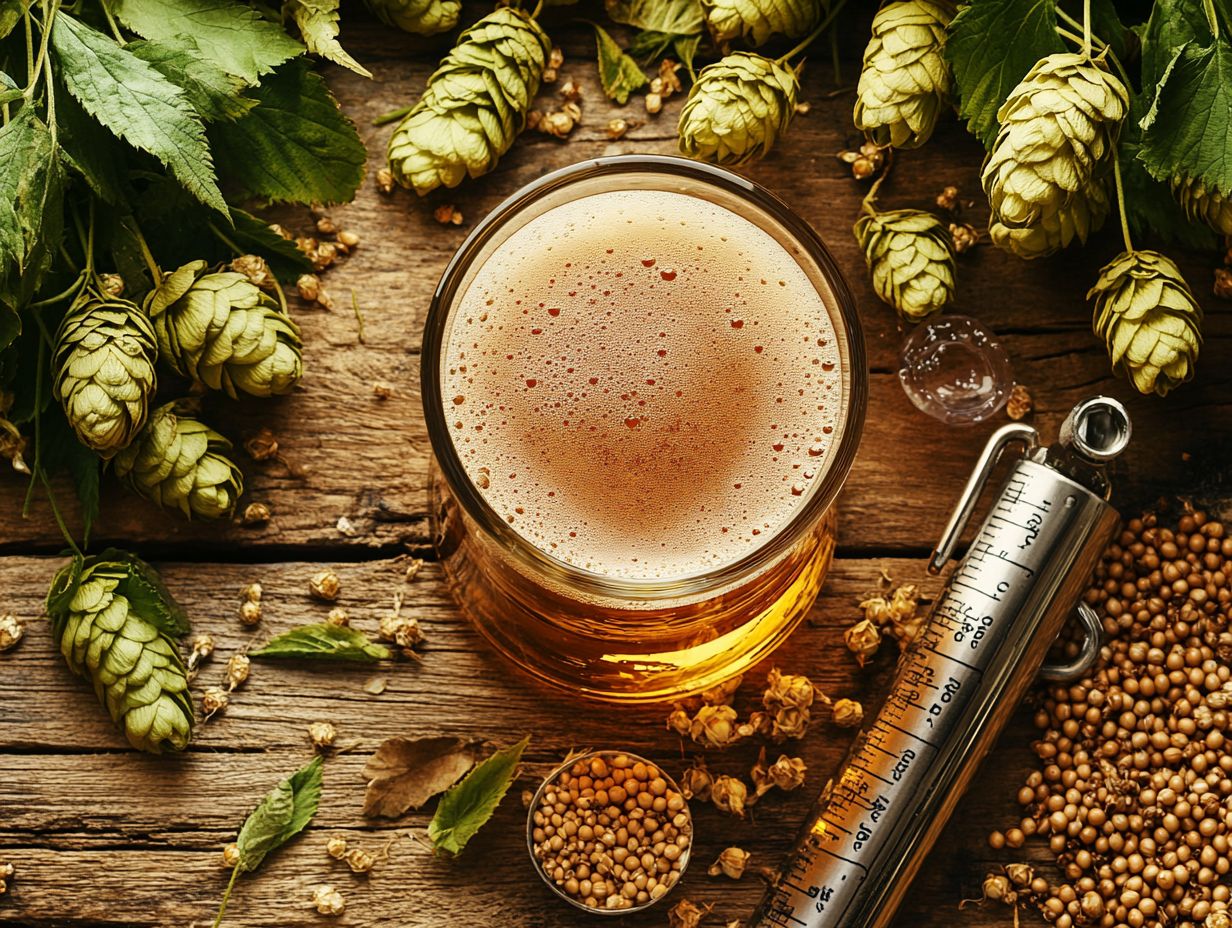
- Identify off-flavors in beer through visual inspection, aroma, and taste, and understand their root causes.
- Common off-flavors include skunky, DMS, diacetyl, acetaldehyde, oxidation, infection, metallic, and phenolic.
- Prevent off-flavors by practicing proper sanitation, using quality ingredients, controlling fermentation, and storing/serving beer properly.
How to Troubleshoot Off-Flavors in Beer
Troubleshooting off-flavors in your homebrewed beer is essential if you aim to produce high-quality products that will impress judges at beer competitions.
Understanding the root causes of these off-flavors, which can stem from brewing problems like excessive warmth or ingredient-related issues such as chlorinated water, will revolutionize your brewing experience and enhance your BJCP score sheet ratings.
By pinpointing and addressing these challenges, you ll be able to craft more palatable and refined beers that truly showcase your brewing expertise and knowledge, potentially leading to better performance in the BJCP.
1. Brewing Process
The brewing process serves as the cornerstone for crafting exceptional home-brewed beer, where each step intricately influences the final product’s taste and aroma. If things aren’t executed just right, you might find yourself contending with off-flavors like DMS that could tarnish your creation.
It s essential for you to grasp each stage of the process from mashing, which transforms starches into fermentable sugars, to boiling, a critical step that not only sterilizes the wort but also allows hops to impart their distinctive bitterness and aroma. Once the boiling reaches completion, you’ll need to cool the wort rapidly before fermentation kicks in. This phase is particularly delicate; the fermentation temperature is key, as temperatures that are too high or too low can lead to undesirable flavors and fermentation problems.
The quality of your ingredients is paramount. Using fresh hops and malt can prevent issues like Diacetyl, that pesky buttery off-flavor that arises from stressed yeast. Stay vigilant against DMS often recognizable by its sweet corn aroma due to poor boiling techniques and minimize oxidation during transfers to greatly enhance your final flavor profile, preventing common oxidation issues.
Now, it’s time to get started on troubleshooting your brewing process immediately!
2. Fermentation
Fermentation is an important stage in the brewing process. It has a direct impact on the taste and quality of your home-brewed beer. When managed effectively, you can avoid common fermentation issues, including off-flavors like Diacetyl and overpowering estery aromas.
During this essential phase, choosing the right yeast type is critical. Different yeast varieties produce distinct flavor profiles and byproducts. For instance, ale yeasts thrive at warmer temperatures typically between 60 F to 75 F while lager yeasts prefer cooler conditions, hovering around 45 F to 55 F. Proper yeast selection can help avoid off-flavors such as ethyl acetate or solvent-like flavor.
The duration of fermentation, usually lasting one to two weeks, also plays a significant role in shaping your beer’s final taste. Insufficient fermentation can leave behind residual sugars, resulting in an unwanted sweetness. On the other hand, overly extended fermentation can introduce off-flavors such as acetaldehyde.
If you encounter undesirable flavors, addressing these concerns involves ensuring proper yeast management, stabilizing temperatures, and allowing for sufficient conditioning time. By doing so, you can achieve a more balanced and enjoyable brew that reflects your brewing skills and minimizes issues like Diacetyl flavor and sour beer.
3. Ingredients
The choice of ingredients is essential in brewing, as they significantly shape the flavor profile of your home-brewed beer. Certain elements, such as chlorinated water or poorly stored grains, can introduce off-flavors like Dimethyl Sulfide (DMS) and oxidation issues that you certainly want to avoid.
You cannot underestimate the importance of high-quality malts. They provide the vital sugars necessary for fermentation while also imparting distinct flavors and aromas. Prioritizing sourcing malts that are fresh and properly stored helps prevent stale or cardboard-like flavors that can detract from your final product.
The hops you select play a crucial role as well, contributing not just bitterness but also aromatic qualities. Stale hops can produce undesirable flavors reminiscent of straw or grass, which you ll want to avoid. Ensuring the freshness of hops can also prevent light-struck or musty aromas.
Water quality is often overlooked, but it deserves your careful attention. Contaminants can shift the beer s taste and aroma in ways you might not want. Using chlorinated water, for instance, can introduce metallic flavors.
And let s not forget about yeast, the silent fermenter. Using healthy, properly propagated yeast strains is essential. It ensures you avoid off-flavors caused by stressed yeast, leading to a cleaner, more flavorful brew overall.
4. Storage and Serving
Mastering proper storage and serving can elevate your home-brewed beer to new heights! Neglecting these aspects can result in off-flavors, such as sour notes and musty aromas, which can completely detract from the intended taste experience.
When you take the time to understand how temperature control plays a vital role in preserving flavors, you enhance your brewing journey. Ideal storage conditions typically involve placing your beer in a cool, dark environment, ideally between 45 to 55 degrees Fahrenheit. Protecting it from light exposure is equally important, as ultraviolet light can degrade the hops, resulting in unpleasant skunky flavors.
Maintaining cleanliness throughout the brewing and storage process is essential to prevent unwanted bacteria from spoiling your batch. By being proactive and closely monitoring these elements, you can ensure that the final product stays true to its intended profile, ultimately enhancing the enjoyment for everyone involved. Proper hygiene practices can also help prevent phenolic or sulfur off-flavors.
How to Identify Off-Flavors in Beer?
Identifying off-flavors is a critical part of the beer judge certification process.
Identifying off-flavors in beer is a vital skill for every home brewer seeking to elevate their brewing process and enhance their BJCP score sheet in competitions. This involves a meticulous approach that combines visual inspection, aroma assessment, and taste evaluation.
By honing this skill, you not only refine your craft but also set yourself apart in the competitive brewing landscape. This can lead to better scores on the BJCP score sheet.
How to Identify Off-Flavors in Beer
1. Visual Inspection
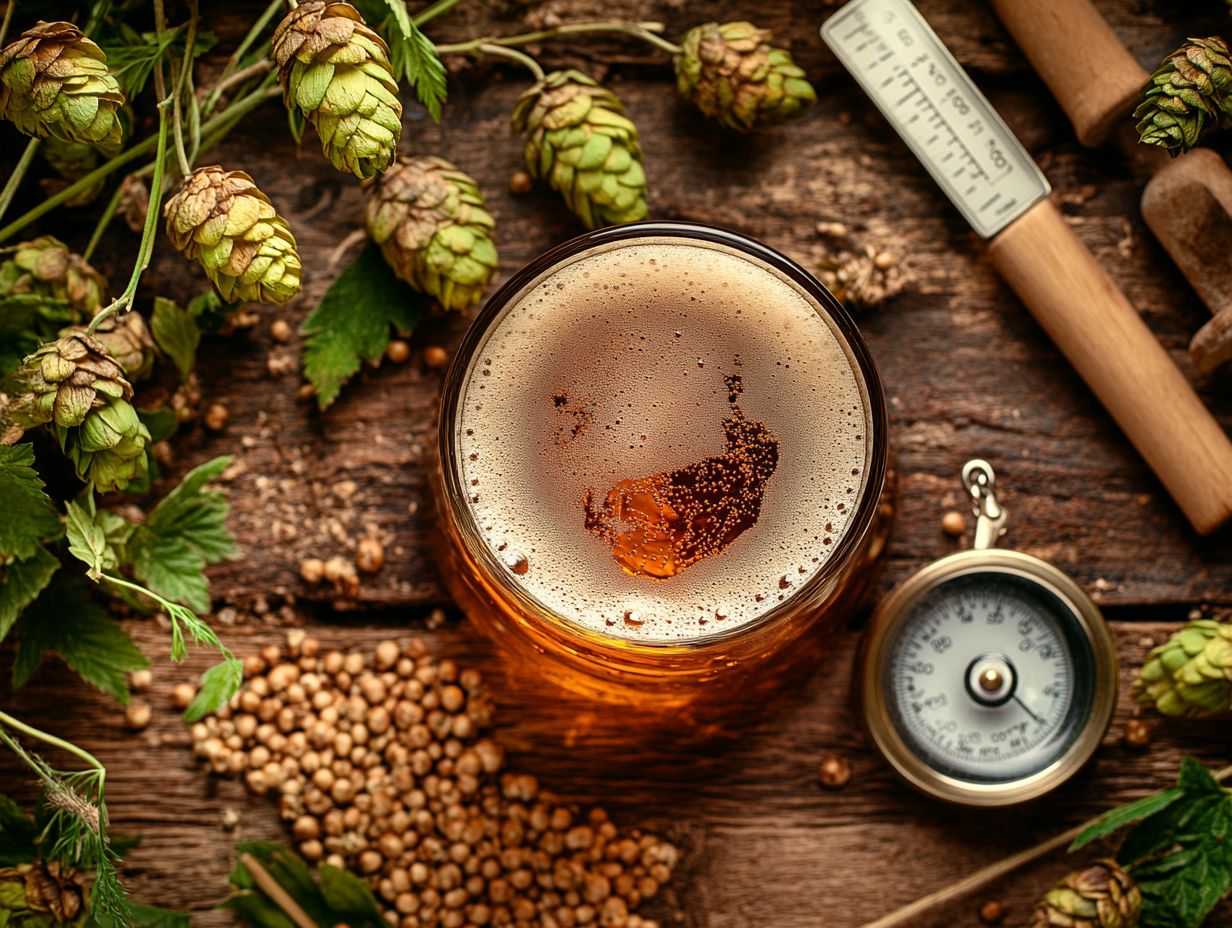
Visual inspection serves as your first line of defense in identifying off flavors in beer, giving you the power to assess clarity, color, and any signs of contamination that could hint at potential off-flavors. This initial observation is essential for evaluating the overall quality of the beverage.
As you examine the beer, focus on clarity, which can range from brilliantly clear to hazy.
A hazy appearance often suggests issues with the fermentation process or interactions among ingredients. Sediment, too, can be a telltale sign of incomplete filtration or leftover yeast, potentially pointing to off flavors that are particularly unpleasant or unintended, such as a yeasty or sulfur note.
An evaluation of color can reveal crucial information about oxidation or spoilage problems. By meticulously observing these visual attributes, you can gain insights that not only refine your brewing practices but also elevate the drinking experience for all, preventing metallic flavors and other spoilage-related issues.
2. Aroma
Aroma plays a pivotal role in detecting off-flavors in beer, revealing a spectrum of problematic scents ranging from estery notes to musty or sour hints that signal potential fermentation or storage issues. Recognizing these aromas can help identify whether the beer has issues like DMS (Dimethyl Sulfide), which can give a cooked corn flavor, or solvent-like flavor.
For brewers and enthusiasts alike, understanding these aromas is essential, as they serve as a way to figure out what’s wrong. Consider, for instance, a banana-like scent; it often points to specific yeast strains at work.
A clove or phenolic aroma might indicate fermentation temperatures that are too high. Grassy or earthy notes could signal oxidized hops or barley, while unpleasant vinegar or acetic acid aromas may suggest contamination.
By recognizing these subtle cues, you can truly appreciate the beer’s character while also pinpointing any flaws that could mar the overall experience, potentially leading to higher scores in beer competitions.
3. Taste
The taste test stands as the most definitive method for identifying off-flavors in beer, where elements like Diacetyl or oxidation can dramatically disrupt the intended flavor profile of your brew.
This sensory evaluation invites you to swish the beer around your palate, enabling you to detect any undesirable tastes that diverge from the expected richness or texture. A buttery flavor, often indicative of elevated Diacetyl levels, serves as a clear sign of fermentation issues or subpar yeast management.
Meanwhile, a cardboard-like taste points to oxidation, frequently stemming from improper storage or packaging. Spotting these off flavors can supercharge your home brewing skills!
You may also encounter specific off-flavors, such as a sharp acidic bite or an overly sweet profile, which can signal contamination or problems during the brewing process. As you taste, it s essential to pay close attention to the balance and complexity of flavors to fully appreciate the significant impact these defects can have on your overall drinking experience.
Common troubleshooting off-flavors like these can be crucial in ensuring the quality of your home brewed beer.
How to Fix Common Off-Flavors in Beer?
Fixing off-flavors in beer is crucial for any home brewer who wants to impress! Grasping how to tackle issues like the buttery notes of Diacetyl, the cooked corn flavors of DMS, or the stale taste brought on by oxidation can truly enhance the quality of your brews, especially when preparing for beer competitions or filling out a BJCP score sheet.
By mastering these techniques, you’re not just brewing beer; you’re crafting exceptional experiences that delight the palate. For those in the Cicerone Certification Program, understanding how to address these fermentation problems is integral to your success.
1. Skunky/ Lightstruck (Light Struck Flavors)
Skunky or lightstruck flavors in beer often arise from exposure to light, particularly UV light, which interacts with the hops and produces undesirable off-flavors that can ruin your entire drinking experience! This issue is common in home brewing environments without proper storage solutions.
You might notice these flavors as a distinct, unpleasant aroma reminiscent of a skunk s spray, which can easily deter even the most devoted beer aficionados. Light exposure, especially from fluorescent lights or direct sunlight, can break down the compounds in hops, leading to the formation of 3-methyl-2-butene-1-thiol (MBT) the culprit behind that notorious skunky flavor.
Identifying these unpleasant flavors is crucial for you. Engaging in a thorough sensory evaluation a process to smell and taste beer to identify flavors where you note any unpleasant aromas or tastes can help you assess the quality of the beer. Common aromas to look out for include musty aromas or estery aromas.
To prevent such occurrences, it s essential to store your beer in dark, cool places and opt for packaging like amber bottles or cans, ensuring that your brew is adequately shielded from harmful light exposure.
2. DMS (Cooked Corn/ Vegetables) (Dimethyl Sulfide Flavor)
DMS, often likened to the flavor of cooked corn or vegetables, is an unpleasant flavor that can significantly mar the overall taste of your beer. It typically arises from inadequate boiling during the brewing process. This DMS flavor can be particularly noticeable in lighter-colored beers.
Identifying this unwelcome flavor is essential for brewers who aspire to craft a clean and refreshing beverage. DMS, or dimethyl sulfide, forms when the precursors from malt, known as DMS precursors, are not fully converted during the boil. This compound tends to emerge in wort that hasn t been boiled sufficiently or when the boiling lacks the necessary vigor, especially in lighter-colored beers.
To prevent DMS formation, you should adopt boiling techniques that guarantee a vigorous boil for at least 60 minutes, ensuring these precursors evaporate. Managing your ingredients wisely using fresh, high-quality malt and minimizing prolonged exposure to heat before the boil is also important in controlling DMS levels in your final product.
3. Diacetyl (Buttery/ Butterscotch) (Diacetyl Flavor)
Diacetyl, with its unmistakable buttery or butterscotch flavor, is an unpleasant flavor that you, as a brewer, need to master in troubleshooting. It can often arise from improper fermentation or yeast management practices. This compound primarily originates from yeast during fermentation, particularly when the yeast is stressed or under-pitched.
To identify diacetyl in your beer, rely on your sensory evaluation skills; that buttery aroma is a telltale sign. By employing effective fermentation strategies like maintaining optimal fermentation temperatures and ensuring a robust yeast pitch you can significantly reduce the chances of diacetyl formation. These strategies are especially important when preparing for the beer judge certification process.
Proper yeast handling is essential, particularly by allowing the yeast to complete a diacetyl rest phase. Managing your ingredients wisely is also important to ensure that your final product remains clean and appealing. Your meticulous approach can truly elevate the quality of your beer.
In conclusion, take the time to assess your brewing practices and experiment with the techniques discussed above. Your efforts can lead to an enhanced brewing experience and better beer quality!
4. Acetaldehyde (Green Apple/ Cut Grass) (Acetaldehyde Flavor)
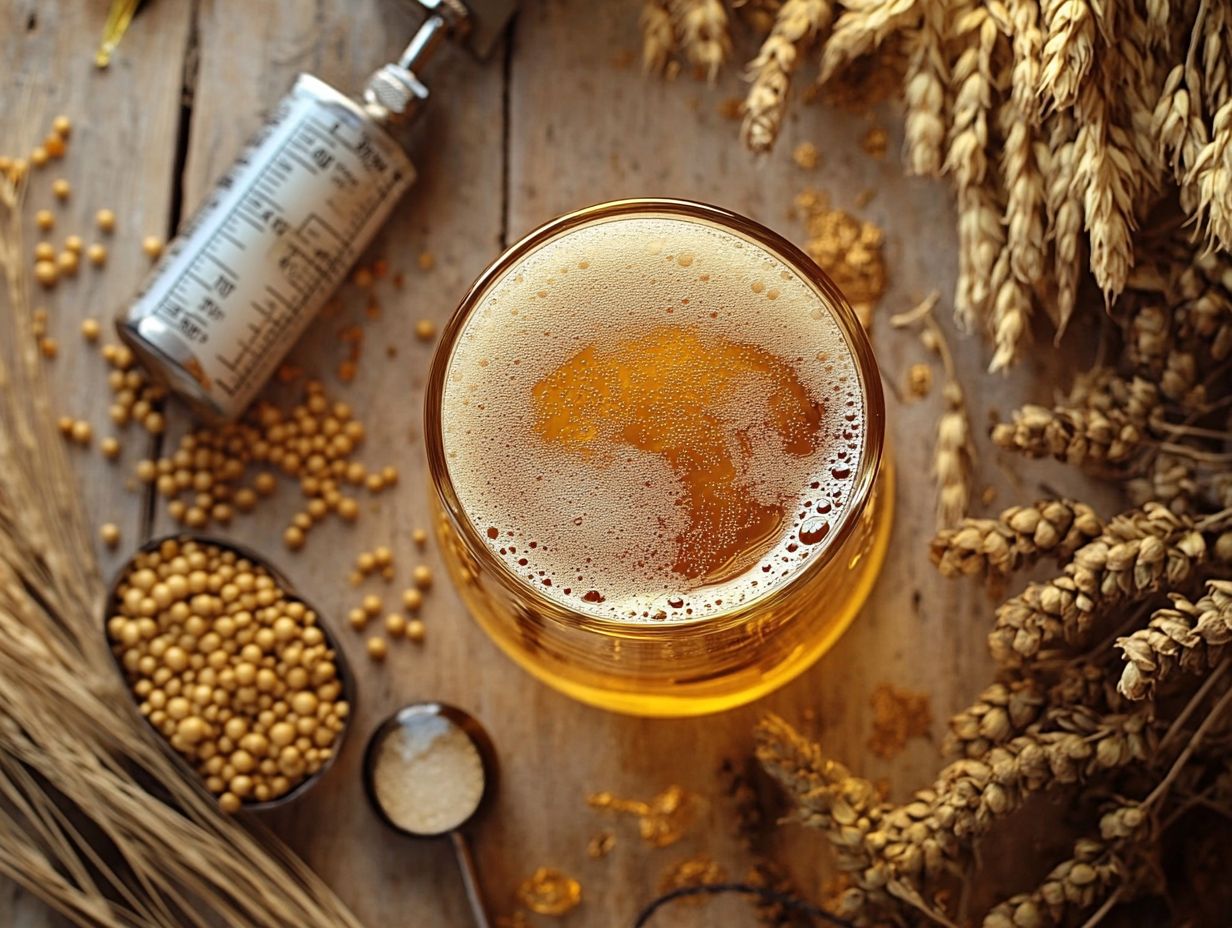
Acetaldehyde is an unwelcome off-flavor often likened to notes of green apple or freshly cut grass. It typically signals incomplete fermentation or potential problems with yeast health during the brewing process. This compound can also result from using chlorinated water that hasn’t been properly treated.
This compound arises when yeast metabolizes sugars into alcohol. Its presence can significantly detract from the overall quality of your beer. To combat the formation of acetaldehyde, you must prioritize proper fermentation practices. This means maintaining optimal fermentation temperatures and ensuring an adequate oxygen supply, particularly during the yeast pitching stage.
Paying close attention to your yeast management is essential. Using healthy, viable yeast cells can drastically reduce off-flavors. Allowing for a longer fermentation period also provides the yeast with ample time to reabsorb acetaldehyde, ultimately enhancing the flavor profile of your final product and promoting a cleaner, more refined taste.
5. Oxidation (Stale/ Cardboard) (Oxidized Flavor)
Oxidation can bring unwelcome stale or cardboard-like flavors to your beer. This often results from improper storage or excessive exposure to air, greatly undermining the quality of your brew. This chemical process occurs when your beer comes into contact with oxygen, particularly during production, bottling, or after it’s been opened. These oxidation issues are particularly problematic for BJCP evaluations.
Recognizing these off-flavors is essential. You might detect hints of sherry or notice a general loss of hop freshness as clear indicators. You may also come across ethyl acetate aromas, often described as solvent-like. To help prevent oxidation, consider these tips:
- Store bottles upright to minimize surface area exposure.
- Opt for dark glass packaging to shield your beer from light.
- Ensure tight seals on caps or corks to limit air ingress.
Drink your beer soon after opening to enjoy it at its best!
6. Infection (Sour/ Vinegary) (Sour Flavor)
Infection in beer can lead to sour or vinegary off-flavors that signal the presence of unwanted bacteria, compromising the intended flavor profile and overall quality of your brew. If these sour beer characteristics emerge unexpectedly, it’s often due to contamination.
Identifying these off-flavors is essential for anyone serious about maintaining the integrity of their products. Look out for pronounced tartness, aromas reminiscent of vinegar, or any hints of wet cardboard, as these all suggest contamination. Usually, these undesirable flavors stem from bacteria such as Lactobacillus or Acetobacter, which can thrive due to improper sanitation or exposure to air. Knowing about these infections is essential for every brewer aiming for top-quality beer!
To prevent such infections, you must adhere to meticulous brewing practices, including:
- Thoroughly cleaning and sanitizing your equipment.
- Maintaining a controlled fermentation environment.
- Ensuring that all ingredients are fresh and free from contaminants.
By focusing on these preventive measures, you can safeguard the quality of your beer and ensure a delightful tasting experience for your consumers.
7. Metallic Flavors
Metallic flavors in beer can often creep in due to the equipment or ingredients you choose, introducing those pesky off-flavors that distract from an otherwise delightful drinking experience. These metallic flavors are often noted during sensory evaluations.
These undesirable notes can stem from various sources, such as poorly coated brewing utensils or contaminated water sources that might leach metallic residues into your final brew. For both the passionate brewing enthusiast and the seasoned master brewer, detecting these subtle metallic hints calls for a discerning palate, revealing themselves as astringent or coppery tastes.
To effectively eliminate these off-flavors, it s essential to invest in high-quality stainless steel equipment and ensure that your water is pre-treated or filtered. Be mindful of the source of your grains and other ingredients to help prevent unwanted metallic characteristics, resulting in a cleaner, more enjoyable flavor profile in every pint you pour. Avoid using chlorinated water as it can contribute to these flavors.
8. Phenolic Flavors
Phenolic off-flavors, often reminiscent of band-aids or medicinal notes, are typically linked to certain types of yeast or brewing conditions that can unintentionally alter your flavor profile. These phenolic compounds can be particularly troublesome in home brewing.
Understanding how these flavors develop is essential for you as a brewer striving for a clean and enjoyable taste. These undesirable characteristics frequently emerge during fermentation when particular yeast types produce phenolic compounds under stress. Temperature fluctuations and improper fermentation practices (the process where yeast converts sugars into alcohol) can amplify this problem, highlighting the need for maintaining consistent temperatures throughout your brewing process.
By choosing yeast strains that are known for their low phenol production and closely monitoring your fermentation conditions, you can effectively keep these off-flavors at bay. Proper fermentation management, especially temperature control, can significantly reduce the risk of these unwanted tastes, ultimately leading to a more harmonious final product.
How to Prevent Off-Flavors in Beer?
Want to enjoy the best beer possible? Start with careful cleaning, select top-notch ingredients, and keep a close eye on your fermentation conditions. These practices are essential for any home brewer. Being aware of potential ethyl acetate and acetaldehyde formation during the brewing process can also be helpful.
1. Proper Sanitation (Chlorinated Water)
Proper sanitation is the foundation for preventing off-flavors like Diacetyl and DMS in your beer. Ensuring that every piece of brewing equipment and ingredient is free from contaminants is essential for maintaining the quality and flavor integrity of your brew.
This meticulous process starts long before you even begin brewing. You’ll want to thoroughly clean and sanitize all utensils, fermenters, and storage vessels involved in the process. By using effective cleaning agents and techniques, such as hot water or specialized sanitizers, you can eliminate harmful microorganisms that could lead to unwanted flavors like metallic or musty aromas.
It s important to understand that impurities can sneak into your brew at any stage whether it s during the handling of raw ingredients or the bottling of the finished product. By committing to rigorous sanitation practices throughout the brewing process, you significantly reduce the risk of off-flavors like sour or solvent-like flavors. This dedication ensures that your final product not only meets but exceeds quality expectations, ultimately enhancing your overall brewing experience.
2. Quality Ingredients
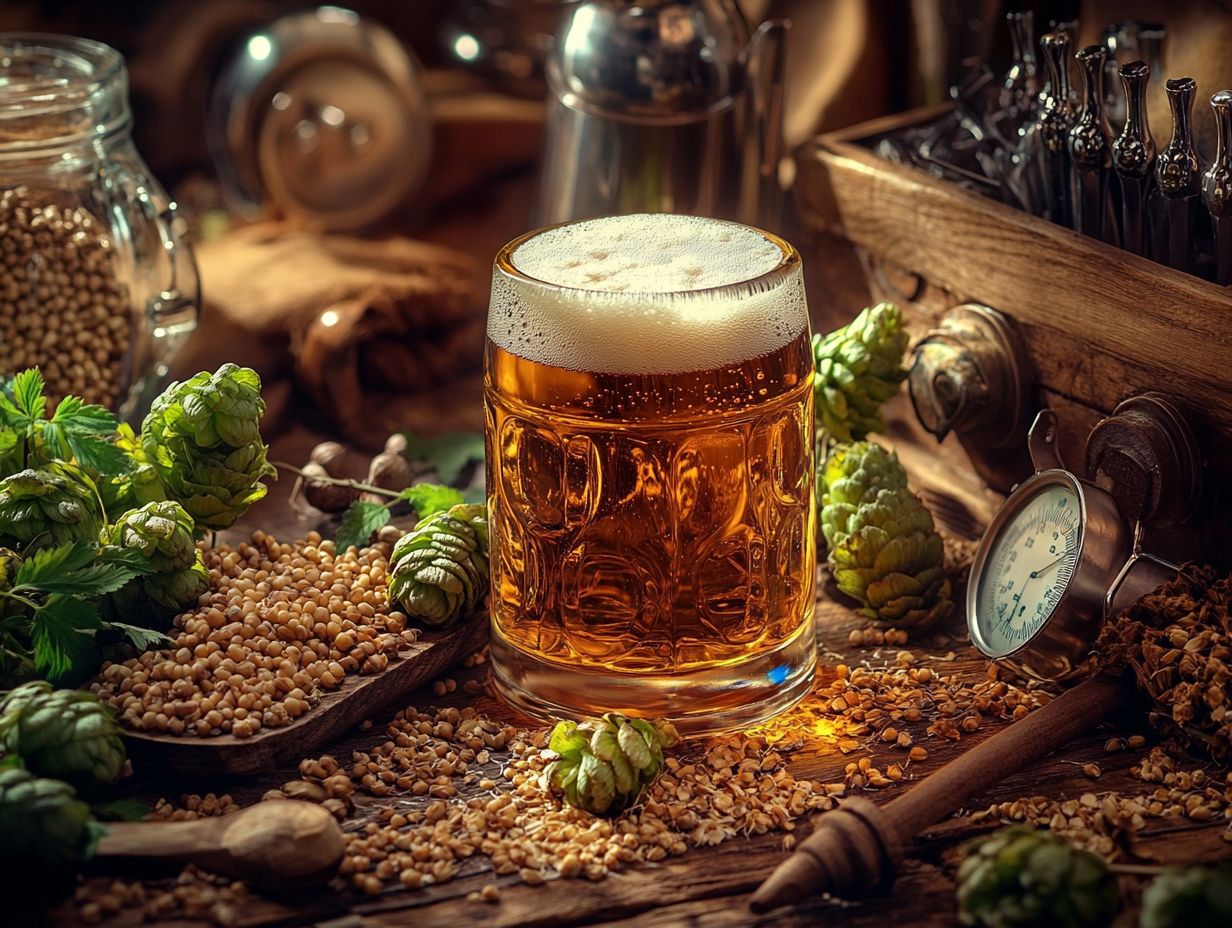
Using quality ingredients is essential for preventing off-flavors like Acetaldehyde in your beer, as the selection and sourcing of malt, hops, and yeast directly affect the flavor of your beer.
When you prioritize high-grade ingredients, you enhance not only the complexity and richness of your beer but also reduce the chances of undesirable flavors that could compromise the final product.
For example, responsibly sourced hops can add unique aromatic qualities that elevate the entire tasting experience. Choosing organic or locally sourced malt ensures greater freshness, which translates into a more vibrant flavor profile.
The integrity of these ingredients is crucial. Investing your time and effort into procuring the finest ingredients is key for achieving a superior brew, especially in home-brewed beer.
3. Controlled Fermentation
Controlled fermentation plays a crucial role in preventing off-flavors in your beer. By managing fermentation temperature and ensuring yeast health, you can significantly influence the final flavor profile, minimizing the risk of undesirable notes like estery aromas or excessive warmth.
As you carefully regulate the temperature during fermentation, you actively shape yeast activity, allowing it to thrive within the optimal ranges for the specific strain you ve chosen. This practice enhances the production of desirable flavors and reduces the likelihood of unwanted compounds that could lead to off-flavors like phenolic or sulfur notes.
Selecting the right yeast strain is crucial; different strains impart unique characteristics, enabling you to tailor the flavor development to your vision. By maintaining yeast health through proper nutrition, you further support a clean fermentation process, ultimately crafting a higher-quality beer that delights the palate.
4. Proper Storage and Serving
Proper storage and serving techniques are essential for maintaining the quality of your beer and preventing undesirable off-flavors. Let s be honest improper conditions can wreak havoc on the flavor and aroma you ve come to love, especially if you are preparing for beer competitions.
To fully appreciate the intricacies of the flavors crafted by your favorite brewers, it s crucial to store your beer in a cool, dark place, ideally between 45 to 55 degrees Fahrenheit. This temperature range is crucial for keeping those hops and malts fresh!
You should also be aware that exposure to light, particularly ultraviolet rays, can introduce skunky flavors to your beer. That s why it s best to keep your bottles away from direct sunlight and harsh fluorescent lighting, which can cause light-struck flavors.
When it s time to serve your beer, don t underestimate the importance of using the right glassware. The right glass not only enhances aroma release but also maintains carbonation. By following these practices, you ll elevate your drinking experience, allowing you to savor each unique brew just as the brewer intended.
Frequently Asked Questions
What are off-flavors in beer?
Off-flavors in beer are unwanted, unpleasant tastes or aromas that can occur during the brewing process. They can vary from metallic or sour notes to a skunky or musty smell. Other common off-flavors include Diacetyl, Acetaldehyde, and DMS.
What causes off-flavors in beer?
Off-flavors in beer can be caused by various factors, including improper brewing techniques, contamination from bacteria or wild yeast, using old or spoiled ingredients, or improper storage or handling of the finished beer.
Fermentation problems, yeast selection, and chlorinated water are also common culprits.
How can I identify off-flavors in beer?
The best way to identify off-flavors in beer is through sensory analysis. This involves using your senses of sight, smell, and taste to detect any off-putting characteristics in the beer.
You can also use off-flavor kits to train your palate and learn to recognize specific off-flavors. Tools like a BJCP score sheet can be invaluable during this process.
Common Off-Flavors in Beer
What are some common off-flavors in beer?
Some common off-flavors in beer include diacetyl (buttery or butterscotch), acetaldehyde (green apple or freshly cut grass), DMS (cooked corn or cabbage), and skunkiness (from exposure to light). Other off-flavors can include metallic, sour, or musty notes.
Solvent-like flavors, oxidation issues, and estery aromas can also affect the taste.
How can I troubleshoot off-flavors in beer?
Kickstart your troubleshooting by reviewing your brewing process, checking for contamination, or testing the quality of your ingredients. Once you have pinpointed the issue, you can take steps to correct it, such as:
- Adjusting your brewing techniques
- Sanitizing equipment
- Using fresher ingredients
Utilizing the BJCP (Beer Judging Certification Program) guidelines or seeking advice from the Cicerone Certification Program can also be beneficial.
Can off-flavors in beer be prevented?
While it is not always possible to prevent off-flavors in beer, there are steps you can take to minimize the risk. This includes:
- Using proper brewing techniques
- Maintaining a clean and sanitary brewing environment
- Using quality ingredients
- Storing the finished beer properly
Don t wait! Regular sensory analysis and off-flavor testing are key to catching issues early, particularly if you’re involved in home brewing or aiming for a high BJCP score.

